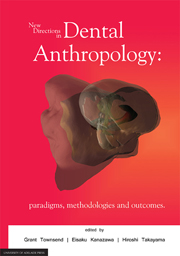Book contents
- Frontmatter
- Foreword
- Contents
- 1 Modelling the complexity of the dentition
- 2 New approaches to dental anthropology based on the study of twins
- 3 Genes for teeth — drawing inference from family data
- 4 Do feeding practices, gestation length, and birth weight affect the timing of emergence of the first primary tooth?
- 5 Sexual dimorphism in the primary and permanent dentitions of twins: an approach to clarifying the role of hormonal factors
- 6 Dental crown and arch size in Europeans and Australian Aboriginals
- 7 Sex determination from maxillary and mandibular canines of the Filipino population
- 8 Non-metric dental characteristics in Papua New Guinea Highlanders and their association with molar reduction
- 9 The Main Occluding Area between opposing teeth during chewing: a comparison between Australians and Japanese
- 10 “Mineral Maintenance” of dental structures in caries and erosive tooth wear: an holistic model
- 11 Emerging techniques for the analysis of tooth wear
9 - The Main Occluding Area between opposing teeth during chewing: a comparison between Australians and Japanese
Published online by Cambridge University Press: 05 May 2013
- Frontmatter
- Foreword
- Contents
- 1 Modelling the complexity of the dentition
- 2 New approaches to dental anthropology based on the study of twins
- 3 Genes for teeth — drawing inference from family data
- 4 Do feeding practices, gestation length, and birth weight affect the timing of emergence of the first primary tooth?
- 5 Sexual dimorphism in the primary and permanent dentitions of twins: an approach to clarifying the role of hormonal factors
- 6 Dental crown and arch size in Europeans and Australian Aboriginals
- 7 Sex determination from maxillary and mandibular canines of the Filipino population
- 8 Non-metric dental characteristics in Papua New Guinea Highlanders and their association with molar reduction
- 9 The Main Occluding Area between opposing teeth during chewing: a comparison between Australians and Japanese
- 10 “Mineral Maintenance” of dental structures in caries and erosive tooth wear: an holistic model
- 11 Emerging techniques for the analysis of tooth wear
Summary
ABSTRACT
The Main Occluding Area (MOcA) defined by Kato (1996) has been found to almost always be located between the upper and lower first molars in Japanese. However, there have not been any reports of this feature in other human populations. In this study, the location of the MOcA was assessed in a sample of 80 Australian dental students as part of an exercise relating to dental occlusion. A piece of stopping material was used to locate the MOcA and to determine the preferred chewing side. There was no significant difference between published findings for Japanese and those for Australians in relation to the location of the MOcA, nor were there any significant differences between the ethnicities represented within the Australian sample. However, there was a difference between ethnicities within the Australian sample in the preferred chewing side, with Asians displaying a preference for the left side. We propose that the location of the MOcA is relatively stable across human populations, having been derived from the tribosphenic biting system of the earliest mammals. The difference observed in preferred chewing side between Europeans and Asians may relate to differences in the use of food utensils between these groups.
INTRODUCTION
During human chewing behaviour, only limited contact occurs between opposing surfaces of the dental crowns. Kato et al. (1996) examined the nature of this contact in Japanese and defined the region where maximum contact occurred as the Main Occluding Area (MOcA). He found that the MOcA was usually located between the functional cusps, ie supporting cusps, of the upper and lower first molars. The importance of this feature when chewing food, is that one tends to clench and begin to chew on the MOcA. An understanding of the position of the MOcA is important for dental treatment and also for placing the pattern of modern human masticatory activity into a broader evolutionary perspective.
- Type
- Chapter
- Information
- New Directions in Dental AnthropologyParadigms, Methodologies and Outcomes, pp. 106 - 114Publisher: The University of Adelaide PressPrint publication year: 2012

